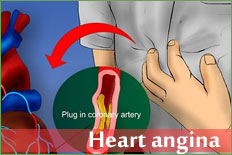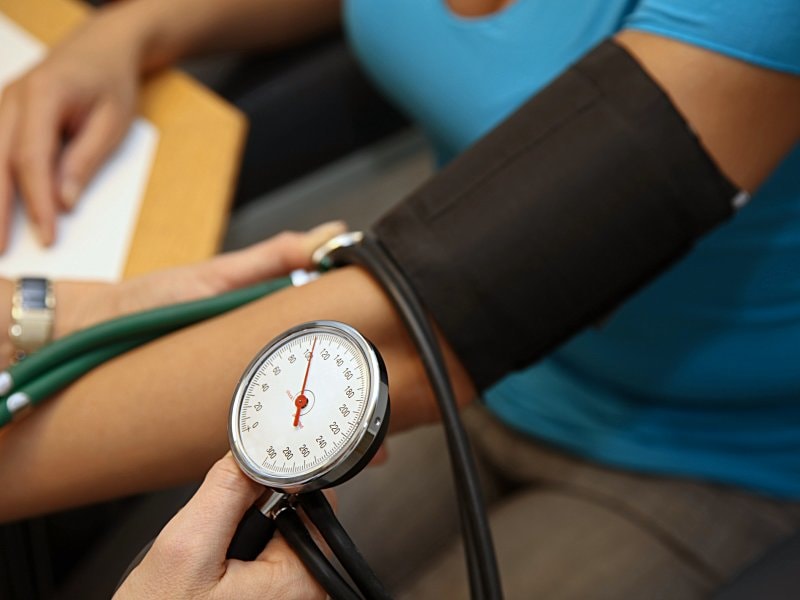Health Centers > Hypertension Health Center > Hypertension Etiology & Classification
Hypertension Etiology & Classification
A. PRIMARY (ESSENTIAL) HYPERTENSION
Primary (essential) hypertension is the term applied to the 95% of cases in which no cause for hypertension can be identified. This occurs in 10-15% of white adults and 20-30% of black adults in the United States. The onset is usually between ages 25 and 55 years; it is uncommon before age 20 years. Much less commonly, hypertension arises from an identifiable cause, in which case it is called secondary hypertension (see below). The secondary form should be suspected in children or young adults and in older persons in whom onset of hypertension is new or in whom hypertension suddenly worsens.
Hypertension Etiology & Classification
- Primary (Essential) Hypertension
L Sympathetic nervous system hyperactivity
L Abnormal cardiovascular development
L Renin-angiotensin system activity
L Defect in natriuresis
L Intracellular sodium and calcium
L Exacerbating factors - Secondary Hypertension
L Renal disease
L Genetic causes
L Renal vascular hypertension
L Primary hyperaldosteronism
L Cushing's syndrome
L Pheochromocytoma
L Coarctation of the aorta
L Hypertension associated with pregnancy
L Estrogen use
L Other causes of secondary hypertension
The pathogenesis of primary (essential) hypertension is multifactorial. Genetic factors play an important role. Children have higher blood pressure when one parent is hypertensive (and more so when both parents are hypertensive). Environmental factors also are significant. Increased salt intake and obesity have long been incriminated.
These factors alone are probably not sufficient to raise blood pressure to abnormal levels but are synergistic with a genetic predisposition. Other factors that may be involved in the pathogenesis of primary (essential) hypertension are sympathetic nervous system hyperactivity, abnormal cardiovascular development, renin-angiotensin system activity, defect in natriuresis, intracellular sodium and calcium, as well as exacerbating factors (including obesity, alcohol, cigarette smoking, and polycythemia).
Editor note: [updated at Dec 2, 2007]
Given this information, the recent Joint National Committee (JNC-7) has introduced a new classification system for hypertension.
- PreHypertension - Systolic blood pressure (SBP) 120-139 mm Hg or diastolic blood pressure (DBP) 80-89 mm Hg
- Stage I hypertension - SBP 140-159 mm Hg or DBP 90-99 mm Hg
- Stage II hypertension - SBP >160 mm Hg or DBP > 100 mm Hg *
Also check Joint National Committee (JNC-6) Classification of Hypertension
1. Sympathetic nervous system hyperactivity - This is most apparent in younger persons with hypertension, who may exhibit tachycardia and an elevated cardiac output. However, correlations between plasma catecholamines and blood pressure are poor. Insensitivity of the baroreflexes may play a role in the genesis of adrenergic hyperactivity.
2. Abnormal cardiovascular development - The normal cardiovascular system develops so that elasticity of the great arteries is matched to the resistance in the periphery to optimize large vessel pressure waves. In this way, myocardial oxygen consumption is minimized and coronary flow maximized. Elevated blood pressure later in life could arise from abnormal development of aortic elasticity or reduced development of the microvascular network. This has been postulated as the sequence of events in low birth weight infants who have an increased risk of hypertension developing in adulthood.
Hypertension Etiology & Classification
Primary (essential) hypertension is the term applied to the 95% of cases in which no cause for hypertension can be identified...
Secondary Hypertension
Approximately 5% of patients with hypertension have specific causes ...
Systemic Hypertension - High Blood Pressure
Fifty million Americans have elevated blood pressure ...
High Blood cholesterol
High Blood cholesterol is one of the major risk factors ...
High blood pressure Epidemiology
Results from cross-sectional studies have shown that blood pressure ...
Hypertension Drug Therapy
There are now many classes of potentially antihypertensive ...
Hypertensive States of Pregnancy
Hypertensive states in pregnancy include preeclampsia ...
Chronic Hypertension in Pregnancy
Patients with chronic hypertension tend to ...
3. Renin-angiotensin system activity - Renin, a proteolytic enzyme, is secreted by the juxtaglomerular cells surrounding afferent arterioles in response to a number of stimuli, including reduced renal perfusion pressure, diminished intravascular volume, circulating catecholamines, increased sympathetic nervous system activity, increased arteriolar stretch, and hypokalemia. Plasma renin levels are classified in relation to dietary sodium intake or urinary sodium excretion.
Renin acts on angiotensinogen to cleave off the ten-amino-acid peptide angiotensin I. This peptide is then acted upon by angiotensin-converting enzyme (ACE) to create the eight-amino-acid peptide angiotensin II, a potent vasoconstrictor and a major stimulant of aldosterone release from the adrenal glands. The incidence of hypertension and its complications may be increased in individuals with the DD genotype of the allele coding for ACE. Despite the role of this system in the regulation of blood pressure, it probably does not play a central role in the pathogenesis of most primary (essential) hypertension; although approximately 10% of patients have high levels, 60% have normal levels, and 30% have low levels. Black persons with hypertension and older patients tend to have lower plasma renin activity, which may be associated with expanded intravascular volume.
4. Defect in natriuresis - Normal individuals increase their renal sodium excretion in response to elevations in arterial pressure and to a sodium or volume load. Hypertensive patients, particularly when their blood pressure is controlled, exhibit a diminished ability to excrete a sodium load. This defect may result in increased plasma volume and hypertension. During chronic hypertension, a sodium load is usually handled normally.
5. Intracellular sodium and calcium - Intracellular Na+ is elevated in blood cells and other tissues in primary (essential) hypertension. This may result from abnormalities in Na+-K+ exchange and other Na+ transport mechanisms. An increase in intracellular Na+ may lead to increased intracellular Ca2+ concentrations as a result of facilitated exchange and might explain the increase in vascular smooth muscle tone that is characteristic of established hypertension.
6. Exacerbating factors - A number of conditions elevate blood pressure, especially in predisposed individuals. Obesity is associated with an increase in intravascular volume and an elevated cardiac output. Weight reduction lowers blood pressure modestly. The relationship between sodium intake and hypertension remains controversial, and some - not all - persons with hypertension respond to high salt intake with substantial increases in blood pressure. Patients with high normal or elevated blood pressures should consume no more than 100 mmol/d of salt (2.4 g of sodium, 6 g of sodium chloride daily).
Excessive use of alcohol also raises blood pressure, perhaps by increasing plasma catecholamines. Hypertension can be difficult to control in patients who consume more than 40 g of ethanol (two drinks) daily or drink in "binges." Cigarette smoking raises blood pressure, again by increasing plasma norepinephrine. Although the long-term effect of smoking on blood pressure is less clear, the synergistic effects of smoking and high blood pressure on cardiovascular risk are well documented. The relationship of exercise to hypertension is variable. Aerobic exercise lowers blood pressure in previously sedentary individuals, but increasingly strenuous exercise in already active subjects has less effect. The relationship between stress and hypertension is not established. Polycythemia, whether primary or due to diminished plasma volume, increases blood viscosity and may raise blood pressure. Nonsteroidal anti-inflammatory drugs (NSAIDs) produce increases in blood pressure averaging 5 mm Hg and are best avoided in patients with borderline or elevated blood pressures. Low potassium intake is associated with higher blood pressure in some patients; an intake of 90 mmol/d is recommended.
There is a growing recognition that the complex of abnormalities termed the "metabolic syndrome" is associated with both the development of hypertension and an increased risk of adverse cardiovascular outcomes. The metabolic syndrome (sometimes also called syndrome X or the "deadly quartet") consists of upper body obesity, hyperinsulinemia and insulin resistance, hypertriglyceridemia, and hypertension. Affected patients usually also have low high-density lipoprotein (HDL) cholesterol levels and have been found to have elevated catecholamines and inflammatory markers such as C-reactive protein. Patients with hypertension should be encouraged to follow the lifestyle changes listed in Table 11-2.
Bibliography
August P: Overview: mechanisms of hypertension: cells, hormones, and the kidney. J Am Soc Nephrol 2004;15:1971. [PMID: 15284282]
Bravo EL: Pheochromocytoma. Cardiol Rev 2002;10:44. [PMID: 11790269]
Failor RA et al: Hyperaldosteronism and pheochromocytoma: new tricks and tests. Prim Care 2003;30:801. [PMID: 15024897]
Freel EM et al: Mechanisms of hypertension: the expanding role of aldosterone. J Am Soc Nephrol 2004;15:1993. [PMID: 15284285]
Hartman RP et al: Evaluation of renal causes of hypertension. Radiol Clin North Am 2003;41:909. [PMID: 14521201]
Lifton RP et al: Molecular mechanisms of human hypertension. Cell 2001;104:545. [PMID: 11239411]
Loney EL et al: Renovascular hypertension. Q J Nucl Med 2002; 46:283. [PMID: 12411868]
Nordmann AJ et al: Balloon angioplasty versus medical therapy for hypertensive patients with renal artery obstruction. Cochrane Database Syst Rev 2003;(3):CD002944. [PMID: 12917937]
Nussberger J: Investigating mineralocorticoid hypertension. J Hypertens Suppl 2003;21(Suppl 2):S25. [PMID: 12929904]
Onusko E: Diagnosing secondary hypertension. Am Fam Physician 2003;67:67. [PMID: 12537168]
Oparil S et al: Pathogenesis of hypertension. Ann Intern Med 2003;139:761. [PMID: 14597461]
Radermacher J et al: Techniques for predicting a favourable response to renal angioplasty in patients with renovascular disease. Curr Opin Nephrol Hypertens 2001;10:799. [PMID: 11706308]
Reaven G: Insulin resistance, hypertension, and coronary heart disease. J Clin Hypertens 2003;5:269. [PMID: 12939567]
Safar ME et al: Vascular development, pulse pressure, and the mechanisms of hypertension. Hypertension 2005;46:205. [PMID: 15911744]
Stas SN et al: Pathogenesis of hypertension in diabetes. Rev Endocr Metab Disord 2004;5:221. [PMID: 15211093]
Strazzullo P et al: Altered renal handling of sodium in human hypertension: short review of the evidence. Hypertension 2003;41:1000. [PMID: 12668589]
Textor SC: Managing renal arterial disease and hypertension. Curr Opin Cardiol 2003;18:260. [PMID: 12858123]
Young WF Jr: Minireview: primary aldosteronism - changing concepts in diagnosis and treatment. Endocrinology 2003;144: 2208. [PMID: 12746276]
* Chobanian AV, Bakris GL, Black HR, et al. Seventh report of the Joint National Committee on Prevention, Detection, Evaluation, and Treatment of High Blood Pressure. Hypertension. 2003;42(6):1206-52. [Medline].
Daily Hypertension News
Vanderbilt study finds hypertension-related visits to emergency rooms on rise in US
“We found that around 25 percent of all…


